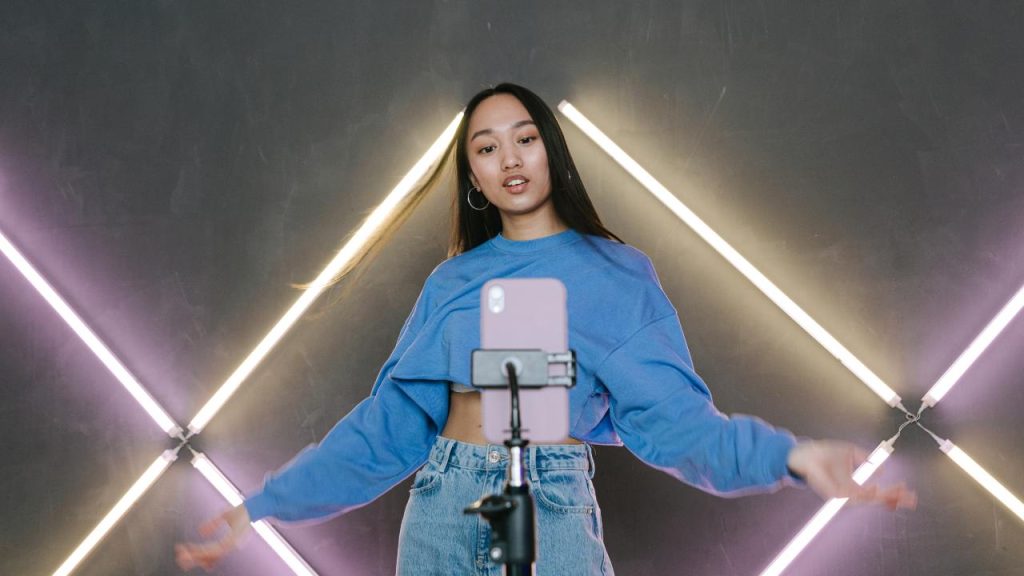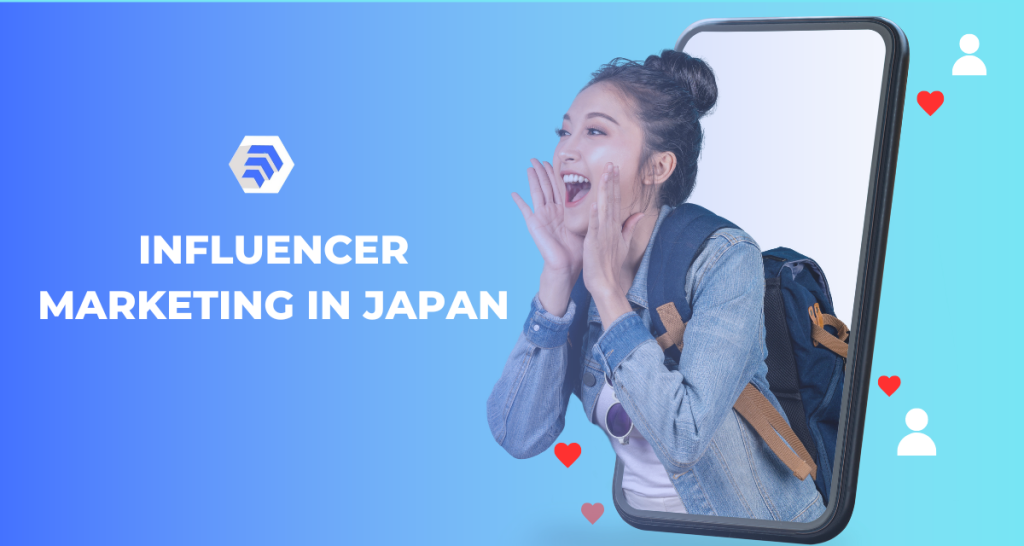Introduction to Influencer Marketing in Japan
Influencer marketing in Japan is a popular and successful method for brands to reach their target demographic. Because Japan is a distinct market with distinct cultural nuances, it’s critical to comprehend how influencer marketing functions in the country.
Influencer marketing in Japan is a type of digital marketing in Japan that is commonly referred to as “tarento marketing”, with “tarento” meaning celebrities or TV personalities. The majority of the top influencers in Japan are TV personalities who have grown a sizable fan base as a result of their appearances on well-known TV programs. These “tarento” are important partners for businesses trying to reach their target audience because they frequently have a large following and are trusted by it.
It’s vital to remember that influencer marketing in Japan is governed by Japanese law. New regulations were established in 2023 to make sure influencer marketing is open and equitable to consumers. According to these rules, influencers must be honest and accurate in their endorsements and disclose any connections they may have with brands.
- Introduction to Influencer Marketing in Japan
- The Landscape of Influencer Marketing in Japan
- Popular social media platforms in Japan
- Key influencer categories
- Influencer Tiers in Japan
- Strategies for Effective Influencer Marketing in Japan
- Measuring success and refining strategies
- Trends in Influencer Marketing in Japan
- Case Studies of Successful Campaigns of Influencer Marketing in Japan
- Challenges and future prospects for influencer marketing in Japan
- Final Thoughts
What is Influencer Marketing
Influencer marketing relies on social proof, where people trust and act on advice from respected individuals. Brands can broaden their reach and build credibility by collaborating with influencers who have sizable, engaged followings on platforms like Instagram, YouTube, and TikTok. Successful influencer marketing involves selecting the right influencers aligned with brand goals and establishing a genuine partnership. This collaboration can include sponsored posts, product reviews, giveaways, and brand ambassadorships, but authenticity and alignment with the brand’s values and the influencer’s audience are crucial for success.
Importance of Influencer Marketing in Japan
For a number of reasons, influencer marketing in Japan has grown in importance in the Japanese marketing environment. The following are some of the main factors that make influencer marketing in Japan significant:
High social media usage: With platforms like Twitter, Instagram, and LINE being popular throughout all age groups, Japan has one of the highest rates of social media usage worldwide. Because of this, influencer marketing in Japan is a successful strategy for firms to connect with their target market where they are most engaged.
Trust and credibility: Over time, Japanese influencers, particularly “tarento” or TV celebrities, have gained the trust and credibility of their following. Because of this, brands seeking to establish credibility and trust with their target market can benefit from working with them.
Unique cultural trends: For brands to succeed in the Japanese market, they must be aware of the country’s particular cultural trends. Brands can better target their marketing efforts to resonate with their target audience by collaborating with local influencers who are aware of these subtleties.
The collaboration between P&G Japan and the Japanese YouTube influencer Hikakintv to promote their Febreze air freshener product is an illustration of a successful campaign of influencer marketing in Japan. Hikakin is a well-known beatboxer and YouTuber with more than 6 million followers. In the campaign, Hikakin produced a video that he subsequently uploaded on his social media accounts, demonstrating how Febreze can be used to get rid of bad odors. The film had over 1.6 million views, and sales of Febreze rose by 58% as a result of the campaign. This campaign demonstrates how collaborating with a local influencer who appeals to the target market can be a successful strategy for firms looking to market their goods in Japan.
Additionally, fan club culture is really strong in Japan, especially for musicians, actors, and sometimes in the manga industry. Normally, you have to pay membership fees to join and some of them have official merchandise. For instance, Naomi Watanabe has an official goods store called Naomi Club Official Store. For Japanese music lovers, you can check this page.
Cultural Context and Uniqueness of the Japanese Market
Understanding the specific cultural context of the Japanese market is essential for firms intending to use influencer marketing in Japan. Observations and illustrations of how influencer marketing might profit from the cultural setting of the Japanese market are provided below:
Long-term relationships and loyalty: Establishing these types of connections with clients is highly valued in Japan. This is seen in the frequent usage of influencers in marketing initiatives. In order to gain the audience’s confidence and credibility, brands may work with the same influencer for an extended period of time.
The value of aesthetics: Japan places a high premium on aesthetics and design. This is illustrated by the use of influencer marketing in Japan by brands to present their goods in visually appealing ways. For instance, the Japanese clothing company Uniqlo frequently collaborates with influencers who have a high sense of fashion and design. These influencers might produce visually appealing content that presents Uniqlo’s products in an aspirational light, aiding in the development of the company’s reputation as a high-end, stylish option.
The popularity of virtual influencers: Virtual influencers are computer-generated characters with unique personalities and followings. Japan has emerged as a global hub for these characters. Younger audiences have embraced these virtual influencers like crazy, and marketers are starting to notice. For instance, to advertise their new automobile model, the Japanese company Lexus teamed up with the online influencer Imma. Imma drove the automobile while displaying its characteristics in the campaign, which was a big success and received millions of views on social media. Imma has collaborated with a lot of luxury brands as well in the past. Imma currently has 400,000 followers on her Instagram account.
Another successful and famous virtual influencer in Japan is Hatsune Miku. She is a CGI influencer developed by Crypton Future Media.
You can find out more about the best virtual influencers in Japan in this article by Gregory Taslaud on INSG.
The significance of authenticity and trust: Authenticity and trust are highly prized, and influencer marketing in Japan initiatives must be open and truthful to be effective. For instance, the Japanese cosmetics company SK-II teamed up with the actress Kasumi Arimura to advertise their goods. To be as genuine and honest as possible, the campaign featured Arimura describing her personal experiences with the products. This aided in establishing trust with the intended audience of SK-II, and the campaign was a big hit, creating a lot of discussion on social media.
The Landscape of Influencer Marketing in Japan
From TV stars and models to social media influencers and virtual influencers, Japan’s influencer landscape is varied and comprises a wide spectrum of individuals. Here are some significant details about the landscape of influencer marketing in Japan:
“Tarento” (TV personalities): TV celebrities, often known as “tarento”, are among the most well-liked influencers in Japan. These people frequently have a large following, and their followers regard them as reliable and credible. Brands can collaborate with tarento to increase credibility and trust among their target market and to present their goods in a more real-world setting. Naomi Watanabe, Becky, and Masahiro Nakai are well-known tarento in Japan.
Musicians: Japanese musicians have long been significant figures in the country’s culture, both inside the music business and in general. Many Japanese singers have large social media followings and use their platforms to promote brands and products, thus their influence goes beyond music.
One notable example is the Japanese rock group ONE OK ROCK, which has worked with companies including Honda, Coca-Cola, and Shu Uemura and has a sizable fan base both in Japan and abroad. By endorsing these companies, the band has gained credibility with its followers and attracted new ones to the brands. Their Youtube channel alone has over 4 million subscribers.
Kenshi Yonezu, a Japanese singer-songwriter, serves as another illustration. With his original songs and music videos, he has a sizable fan base on social media and YouTube with a whopping over 6 million subscribers. His songs have been featured in commercials for companies like SoftBank, UNIQLO, and Nissin Foods, and his fame has increased the brand’s visibility and sales.
The fashion sense of Japanese musicians is well-known, and many of them serve as brand ambassadors for clothing companies like UNIQLO, GU, and ZARA. Their dress choices have an impact on Japanese fashion trends, and they can increase sales and brand awareness by endorsing particular clothing lines.
Comedians: Comedians are also influential figures in Japan, with many having massive followings on social media platforms. They are known to use humor and satire to address societal issues and promote products, making them a popular choice for brand collaborations.
Naomi Watanabe is one instance of a comedian who has influence in Japan. She is one of the most well-known individuals in the country with more than 9 million Instagram followers. She has worked with numerous companies, including Shiseido and Foodpanda, and has received recognition for her efforts to advance diversity and body positivity.
Kentaro Kobayashi is another comedian who has gained popularity as an influencer. On Twitter, he has more than 80,000 followers, and he has worked with companies including Uniqlo and Toyota. He has utilized his popularity to support social issues including blood donation and disaster relief activities. He is renowned for his distinctive sense of humor.
Social media influencers: Instagram and YouTube are two of the most well-liked platforms in Japan for social media influencers. These influencers frequently have a specialized fan base and are quite powerful in their own field of specialization. For instance, the food blogger SoraNews24, who is well-known for her evaluations of unusual and odd delicacies in Japan, has amassed a significant following on Facebook. To reach a particular target demographic and market their products in a more genuine and relatable way, brands can collaborate with social media influencers.
Models: Models are well-liked social media influencers in Japan and frequently have large followings. These people are frequently regarded as trendsetters and have significant influence in the fashion and beauty sectors. In order to promote their products in a visually appealing manner and to capitalize on their sense of style and aesthetic, brands might collaborate with models. One famous model in Japan is Rola with 8.7 million Instagram followers. She is a Japanese fashion model with Russian, Bangladeshi, and Japanese ancestry. She is also a TV personality and is well-known as a model for her recurring roles in advertisements and the Japanese fashion magazine Vivi.
Virtual influencers: Virtual influencers, which are computer-generated characters with unique personalities and fan bases, have also become popular in Japan. These online influencers are well-liked by younger audiences and have significant power in industries like gaming and fashion. For instance, the online influencer Kizuna AI has over 3 million YouTube subscribers and has collaborated with companies like Toyota and SoftBank.
Japan’s influencer environment is varied and presents a variety of chances for organizations wishing to use influencer marketing in Japan to connect with their target audience. Brands may take advantage of the distinctive attributes of each sort of influencer to market their products in an interesting and effective manner, whether they team up with tarento, social media influencers, models, or virtual influencers.
Popular social media platforms in Japan
Social media websites are essential for influencer marketing in Japan. Consumer behavior and purchase decisions are significantly influenced by social media influencers. Here’s a closer look at some of the well-known social media sites in Japan and how influencer marketing relates to them:
LINE: Over 94 million Japanese use the texting service LINE, which is well-liked in Japan. Users of LINE can place audio and video calls, and share messages, images, and videos. It is a perfect platform for influencer marketing in Japan because it also has a variety of activities including games, stickers, and shopping. Through various campaigns, such as LINE stamp campaigns, which let users send branded LINE stickers in their messages, brands can work with LINE influencers to promote their goods and services.
X: For breaking news and real-time updates, X is a well-liked site in Japan. It serves as a platform for journalists, legislators, and public figures. To reach a large audience and increase brand exposure, brands can collaborate with Twitter influencers. Influencers on Twitter can offer live updates and pictures from events to generate buzz and excitement for a business. According to the article on Comnico, Twitter in Japan has the following number of users:
- Number of monetizable daily active users (mDAU): 238 million (as of July 2022)
- Number of monthly active accounts in Japan: over 51.8 million (May 2023)
Instagram: Particularly among younger audiences, Instagram is becoming more popular in Japan. Instagram influencers are a crucial component of Japanese influencer marketing. Brands frequently utilize them to aesthetically enliven product displays and raise consumer awareness of their names. Instagram influencers in Japan work with a lot of fashion, beauty, and lifestyle brands to produce sponsored posts, stories, and reels. According to Comnico, Instagram Japan has the following statistics
- Monthly Active Accounts (MAA): Over 2.35 billion (as of August 2023)
- Number of monthly active accounts in Japan: 49.1 million (as of January 2023)
YouTube: Many Japanese producers have sizable fan bases on YouTube, which is another well-liked medium in Japan. Brands frequently engage YouTube influencers to provide sponsored content such as product reviews and tutorials. For instance, beauty companies frequently work with YouTube stars to provide cosmetics tutorials and product evaluations. Based on Comnico’s article, YouTube has the following numbers
- Number of active users: Over 2.7 billion (as of August 2023)
- Number of active YouTube users in Japan: Over 78 million (as of May 2023)
Facebook: One of the reasons for Facebook’s popularity in Japan is its user-friendly interface and the ability to connect with friends and family overseas. Many Japanese people use Facebook to stay in touch with friends and relatives living abroad. Facebook is also a popular platform for businesses to promote their products and services to a global audience. According to Comnico, Facebook Japan’s statistic is currently at
- Monthly active users: over 3 billion (as of August 2023)
- Number of daily active users: over 2 billion (as of August 2023)
- Number of active users in Japan: 57 million (as of January 2023)
TikTok: TikTok is becoming more and more well-liked in Japan, especially among younger audiences. Brands frequently work with TikTok influencers to produce breezily produced videos that advertise goods or services. In Japan, a lot of firms use TikTok to develop viral campaigns like dancing challenges that spread awareness and engage a larger audience. Comnico reports that Tiktok has currently the following stats
- Number of active users in Japan: 18.9 million (as of July 2023)
- Number of users worldwide: 1.1 billion (August 2023)
Pinterest: Compared to previous years, Pinterest’s user base has slightly increased, but it has done well to serve a devoted and active community of designers, artists, and those seeking inspiration for their creative work. Comnico says that Pinterest’s numbers are the following
- Monthly active users: 465 million (as of June 2023)
- Number of active users in Japan: 6.93 million (as of September 2023)
Ameba Blog: Ameba is a microblogging platform that is comparable to platforms like WordPress but with several amusing differences, like customizable avatars that let users interact with other users in virtual spaces. According to an article on Serkantoto, Ameba has over 22 million users.
Lips: Lips is Appbrew’s community and word-of-mouth marketing app that is focused on cosmetic and beauty products. Appbrew is a Japanese startup. It was first released in January 2017, enabling users to look up reviews of cosmetics. Users can gather information about cosmetics they are interested in or write reviews of cosmetics with accompanying photographs. The number of downloads had surpassed 550,000 as of February 2017.
Jim Kersey posted on Humble Bunny an informative article about Japan’s Top Social Media Networks for 2023.
Because of the variety of social media platforms used, there is much potential for firms to use influencer marketing in Japan. The platforms that are most popular with their target demographic should be carefully considered by brands hoping to succeed with influencer marketing in Japan. They should also select influencers who are appropriate for their brand and message.
You can check out our Digital Marketing in Japan article to learn more about top social media platforms in Japan.
Guide to Digital Marketing in Japan
Key influencer categories
In Japan, there are various influencer categories, each with its own unique characteristics and audience demographics. Here are some of the key influencer categories in Japan:
Beauty and Fashion

Influencers in the fields of beauty and fashion are among the most well-liked in Japan. These influencers produce material centered on beauty and fashion trends, such as styling advice, product reviews, and cosmetics tutorials. Here are some interesting facts and thoughts regarding Japanese fashion and beauty influencers:
In Japan, Instagram is the most popular medium for beauty and fashion influencers. As of January 2023, Instagram had more than 45 million users in Japan, according to Statista. It provides a useful platform for firms to use influencer marketing in Japan because many of these individuals follow beauty and fashion influencers.
Over $35 billion in size of the beauty business in Japan, making it a valuable market for fashion and beauty influencers. Many of these influencers collaborate with skincare and beauty companies to advertise their goods, frequently writing sponsored blog posts, Instagram stories, and Reels.
Numerous brands respond to the distinct demands and interests of Japanese consumers, which makes the Japanese beauty market exceptional. Japanese beauty and fashion influencers are essential to helping firms connect with their target market and provide content that appeals to them.
Japanese beauty and fashion influencers frequently appeal to a sizable female audience; some have followings of over one million. In other Asian nations like China and South Korea, several of these influencers also have sizable fan bases. Some of the notable beauty influencers in Japan are the following:
Rola with 8.7 million followers on Instagram.
Yukirin World with 584,000 subscribers on YouTube.
Yoshida Akari with 945,000 subscribers on YouTube.
Food and cooking
Influencers in Japan are particularly active in the food and cooking niches, with Instagram and YouTube serving as their main distribution channels. They produce content that focuses on cooking methods, restaurant reviews, and recipes. Here are some interesting facts and illustrations of Japanese chefs and cuisine influencers:
The two most popular social media channels in Japan for food and cookery influencers are Instagram and YouTube. In Japan, there are over 78.4 million YouTube subscribers, according to Statista. These networks are useful for brands looking to leverage influencer marketing because many consumers follow food and cooking influencers.
Japan’s over $680 billion food and beverage business, as of 2023, makes it an attractive market for food and cookery gurus. Many of these influencers collaborate with food brands including eateries, supermarkets, and food producers to produce sponsored blog posts, articles, and films to advertise their goods and services.
In Japan, female audiences make up a sizable portion of the audience for food and cooking gurus, who have fans from a variety of ages, genders, and nations. In other Asian nations including China, South Korea, and Taiwan, several of these influencers have sizable fan bases.
Famous cookery author and TV personality, Harumi Kurihara, has more than 600,000 Instagram followers. She is a well-liked influencer in the Japanese culinary and cooking scene and is renowned for her simple-to-follow cooking methods and recipes.
Over 5 million people subscribe to the YouTube channel JunsKitchen, which features cuisine with a Japanese flair. Jun Yoshizuki, the owner of the channel, interacts with his viewers while showcasing his culinary abilities.
Lifestyle and Travel
Influencers in the lifestyle and travel niches are well-liked in Japan, especially on YouTube and Instagram. These influencers produce content about a range of fashion, food, fitness, health, adventure, and culture-related lifestyle and travel trends. Here are some interesting facts and observations about Japanese lifestyle and travel influencers:
In Japan, the two main channels for lifestyle and travel influencers are Instagram and YouTube. Because so many of these users follow travel and lifestyle influencers, it provides a useful platform for marketers to use influencer marketing.
Over $140 billion is spent on travel each year in Japan, making it a valuable market for travel influencers. To advertise their goods and services, many of these influencers collaborate with travel firms like airlines, hotels, and tour operators, frequently producing sponsored posts, stories, and films.
Lifestyle and travel influencers in Japan frequently have a varied audience made up of fans of different ages, genders, and nations. Additionally, several of these influencers have sizable fan bases in other Asian nations like China, South Korea, and Taiwan.
Jun Yoshizuki, a culinary and travel influencer with over 200,000 Instagram followers, and Bilingirl Chika who has more than a million subscribers on Youtube are just a couple of influencers in this category. You can also check more in this list here.
With numerous businesses providing goods and services that are tailored to the particular needs and tastes of Japanese consumers, the leisure and travel sector in Japan is exceptional. Japanese lifestyle and travel influencers are essential for connecting brands with their target market and developing content that appeals to them.
Struggling To Close Sales in Japan?
Gaming & Technology
Influencers in the gaming and technology industry are well-liked in Japan, especially on Twitch and YouTube. They produce video game-related content, such as game reviews, playthroughs, and tutorials. Many of these influencers cater to young male audiences, and some of them have fan bases that exceed one million. Influencers in Japan are particularly active in the gaming and technology niches on websites like YouTube and Twitch. Here are some instances of Japanese influences in gaming and technology:
PewDiePie – Although not a Japanese influencer, PewDiePie is one of the most well-known video game influencers worldwide and has a sizable fan base in Japan. He has more than 111 million YouTube subscribers and makes material about a range of games, such as horror games, action games, and independent games.
MasuoGames: MasuoGames is a well-known YouTube channel that posts gameplay clips and game reviews. With over a million members, the channel is renowned for its humorous approach to gaming videos.
HikakinGames – HikakinGames is a YouTube channel that posts technology-related information together with gameplay videos and reviews of various games. With over 2 million subscribers, the channel is renowned for its upbeat approach to gaming entertainment.
A virtual YouTuber named Kiryu Coco broadcasts gameplay videos on sites like Twitch and YouTube. She has a sizable fan base in Japan and has even worked with well-known game developers like Square Enix and Nintendo.
Mai Fujimoto: Also known as Miss Bitcoin, Mai Fujimoto is a popular blockchain and cryptocurrency influencer in Japan. She runs her own blockchain consulting firm and has been featured in various tech publications.
With a variety of personalities and content kinds, these examples demonstrate the diversity of gaming and technology influencers in Japan. In these categories, brands intending to use influencer marketing in Japan should carefully assess which influencers align with their brand and message and develop campaigns that appeal to their target audience.
Parenting & Family
Influencers in Japan also frequently create content about their experiences as parents and caregivers, making parenting and family another popular topic. Here are some instances of a Japanese family and parenting influencers:
Greg Wickherst @thehairdad on Instagram features a lot of posts about his kids and how to do their hair.
Kimono Mom, who has more than 1 million subscribers on YouTube, posts vlogs about being a mom and a wife.
Sports Influencers
Influencers who specialize in sports, as well as health and well-being, are very common in Japan. Many of them create material about their experiences playing different sports. Here are a few instances of Japanese sports influencers:
One of the most well-known sports influencers in Japan is the professional tennis star Naomi Osaka. With more than 2 million Instagram followers, she has a sizable online fan base.
Yuzuru Hanyu is a two-time Olympic gold medallist and a professional figure skater. With more than 1 million followers on Twitter and more than 300,000 followers on Instagram, he has a sizable social media following.
Asuka Cambridge is a sprinting specialist and a professional track & field athlete. With more than 47,000 Instagram followers, he has a sizable online following.
One of the greatest Japanese footballers in history, Shunsuke Nakamura is a retired professional football player. With more than 400,000 Twitter followers and more than 18,000 Instagram followers, he has a sizable online fan base.
These instances show the diversity of Japanese sports influencers, from individual athletes to teams, who have sizable social media followings. Sports-related brands wishing to use influencer marketing in Japan should choose the influencers who are most appropriate for their brand and design campaigns that reflect the preferences and ideals of their target demographic.
It is important to note that many Japanese influencers work in a variety of domains and cover a variety of categories. The categories that are most pertinent to their business and message should be carefully considered by brands wishing to collaborate with influencers in Japan. Influencers who are compatible with their target audience should be selected.
Influencer Tiers in Japan

In Japan, influencer tiers are categorized based on their level of influence, reach, and engagement. Here are the four main tiers of influencers in Japan, along with examples and their projects:
Mega-influencers
Top-tier influencers with sizable fan bases and tremendous power over their audience are known as mega-influencers in Japan. These influencers frequently include celebrities, well-known models, and media figures, and they frequently have over a million followers. Because of their capacity to connect with a large audience and generate tremendous engagement, they are widely sought after by companies.
Mega-influencers in Japan include, for instance:
Kyary Pamyu Pamyu is a pop singer, model, and fashion star with more than 1 million Instagram followers. She has worked with numerous companies, including Mac Cosmetics, Coca-Cola, Shu Uemura, and Adidas.
Macro-influencers
Macro-influencers are second-tier Japanese influencers with sizable fan bases and sway over their specialized fields. They frequently have between 100,000 and 1 million followers and are quite active on social media. In order to reach a particular target market and increase product sales, brands frequently collaborate with macro-influencers.
Micro-influencers
The third-tier influencers in Japan are known as “micro-influencers,” and they have smaller audiences but higher engagement rates. They often have between 10,000 and 100,000 followers, and their audience values them much for their sincerity and knowledge in their particular niche. Brands frequently collaborate with micro-influencers to reach their engaged audience and increase brand recognition.
In Japan, an illustration of a micro-influencer is Patisserie Sakimoto who has 19,00 followers on Instagram and posts their products to sell online.
Nano-influencers
The lowest rung of influencers in Japan are known as “nano-influencers,” who have smaller audiences but a high level of audience trust and authenticity. They often have 1,000 to 10,000 followers and are frequently thought leaders in a certain group or niche. To benefit from their specialized knowledge and increase targeted brand awareness, brands frequently collaborate with nano-influencers.
Strategies for Effective Influencer Marketing in Japan
Influencer marketing in Japan can be a successful strategy for reaching a specific audience and raising brand awareness, but it takes careful planning and strategic thinking. The following are some methods for successful influencer marketing in Japan:
Identifying the right influencers
Identifying the right influencers is a critical step in influencer marketing in Japan as it determines the success or failure of a campaign. Here are some steps to help identify the right influencers:
Relevance to the target audience
One of the most crucial elements to take into account when choosing the appropriate influencers for a campaign in influencer marketing in Japan is relevance to the target audience. The influencer needs to have a following that is enthusiastic about the company or item being promoted for a campaign to be successful. When determining relevance to the target audience, keep the following in mind:
Demographics: The influencer’s audience should be similar to the target audience in terms of demographics. Age, gender, locality, and interests are included in this.
Niche: Having a niche that is pertinent to the brand or item being pushed is a must for influencers. Partnering with influencers who focus on health and well-being, for instance, would be more appropriate if the firm sells organic food goods.
Authenticity: Genuine interest in the brand or product and authenticity in the influencer’s material are essential. Analyzing their prior content and interactions with their audience can reveal this.
Engagement: The influencer should have a high audience engagement rate. This pertains to the shares, likes, and comments made on their content. High engagement rates show that the influencer’s content is relevant to their audience, and they are therefore more likely to be successful in marketing the brand or item.
Trust: The audience should have faith in the influencer. This can be assessed by looking at their prior partnerships and the audience feedback they have gotten.
Authenticity and credibility
When selecting the ideal influencers for influencer marketing in Japan, authenticity and trustworthiness are two important variables to take into account. Both elements can have a big impact on a campaign’s success since audiences are more likely to engage and trust influencers who are real and trustworthy.
The genuineness and openness of the influencer’s content are referred to as authenticity. Influencers who are genuine express their true personalities, values, and opinions through their work. Their content feels authentic and accessible since they are direct and honest with their viewers. Genuine influencers aren’t hesitant to admit their weaknesses, which can help them establish a stronger rapport with their audience and gain their trust.
Credibility is a term used to describe a specialty or industry influencer’s knowledge and status. Influencers who are trustworthy have a solid reputation and are valued by their audience for their expertise and life experiences. They have the power to shape the beliefs and actions of their audience because they are seen as authorities in their subject.
Authenticity and trustworthiness should be evaluated by brands based on the following factors:
Content Quality: Consider the production value, uniqueness, and inventiveness of the influencer’s content when assessing its quality. Credible influencers might create more instructive or useful content, whereas genuine influencers frequently take a distinctive and creative approach to their content.
Engagement Rates: Review the influencer’s engagement numbers to ascertain how well their audience responds to their content. A deeper connection between the influencer and their audience is shown by higher engagement rates, which may be an indication of genuineness.
Previous Collaborations: Look at the influencer’s prior partnerships to see if they have already collaborated with brands from a similar sector or ghetto. It may be a sign of a lack of authenticity if the influencer has a history of working with brands that are unrelated to their specialization.
Industry Recognition: Examine the influencer’s recognition in the industry, including any awards, writings, or speaking engagements. Industry experts frequently acknowledge credible influencers for their accomplishments and contributions to their sector.
Engagement rates
When choosing the ideal influencers for influencer marketing in Japan, engagement rates are an important consideration. The degree of interaction between an influencer and their audience on social media platforms is measured by engagement rates. A stronger relationship between the influencer and their audience is indicated by higher engagement rates, which can result in more effective advertising.
The number of likes, comments, shares, and views that an influencer’s post receives can be used to gauge engagement rates. The likelihood that the influencer’s content is connecting with their audience increases with the engagement rate. Engaging material can increase the influencer’s followers’ trust in them and their relationship with them, which can increase the campaign’s conversion rate.
It’s critical to consider influencer engagement rates in addition to follower counts when choosing the ideal influencers. Influencers with a sizable fan base can not always have great engagement rates, making them a poor pick for a campaign. Instead, companies want to think about collaborating with micro- or nano-influencers, who might have smaller fan bases but better engagement rates.
It’s also critical to consider the kind of engagement an influencer is getting. While likes and views may not always result in a greater conversion rate, comments, and shares might show a stronger bond between the influencer and their audience. The tone of the remarks and whether they are good or negative should also be taken into account by brands.
Developing a compelling campaign

Creating a captivating campaign is a key tactic for the success of influencer marketing in Japan. The target audience’s attention can be attracted through a compelling campaign, which can also increase engagement and conversion rates.
Developing a compelling campaign requires aligning with brand values and objectives, tailoring content for the Japanese audience, and balancing creative freedom with brand guidelines. Let’s take a closer look at each of these below:
Aligning with brand values and objectives
A successful influencer marketing pin in Japan should be consistent with the goals and values of the brand. This means that the campaign’s messaging and core ideals should be reflected in its content. This ensures that the campaign supports the brand’s broader marketing strategy and helps to establish trust with the campaign’s target demographic.
Tailoring Content for the Japanese Audience
Understanding the distinct cultural background of the market is crucial to developing successful influencer marketing in Japan. This entails being aware of the tastes, values, and interests of the Japanese public. The campaign’s success can be increased by modifying the campaign’s content to address these particular needs.
Balancing creative freedom with brand guidelines
Influencers frequently have a distinctive voice and creative flair, which has helped them succeed. Brands must strike a balance between the requirement for creative flexibility and brand standards when dealing with influencers. This entails laying out precise standards for the campaign’s content while still allowing the influencer to exhibit their particular sense of style and voice.
The collaboration between Adidas and Japanese YouTuber Megwin is another illustration of a successful strategy of influencer marketing in Japan. Megwin was featured in the advertisement taking part in the Adidas 24-hour running challenge and sharing his experience online. Adidas’ brand awareness improved as a result of the campaign’s high interaction rates and relevance to Megwin’s audience.
Leveraging cross-platform marketing
Leveraging cross-platform marketing in influencer marketing in Japan requires utilizing multiple social media channels and integrating influencer content into other marketing efforts. Here are some more details on each subtopic:
Utilizing multiple social media channels
Utilizing several social media platforms: In order to reach a larger audience, influencer marketing in Japan might profit from using many social media platforms. An influencer might publish content during a campaign, for instance, on Instagram, Twitter, and YouTube. This enables the campaign to connect with audience segments that favor various channels. Additionally, the business may strengthen its messaging and raise the likelihood that the campaign will become viral by leveraging various platforms.
Integrating influencer content into other marketing efforts
Influencer content integration into other marketing initiatives: Influencer material can be included in marketing initiatives outside of social media, such as email marketing, website content, or advertising. To further advertise the business and its products, a brand may, for instance, include influencer material on its website or in an email marketing campaign. This can broaden the campaign’s influence and impact while establishing a consistent brand message across all available marketing channels.
The partnership between the influencer Risa Nakamura and the Japanese cosmetics brand Shu Uemura is an illustration of cross-platform marketing in influencer marketing in Japan. As part of the promotion, Nakamura posted videos on YouTube and Instagram exhibiting the company’s products and showing viewers how to utilize them. The company included content from the influencer in its email marketing efforts and on its website. This enhanced the brand’s messaging across several marketing platforms and helped the campaign reach a larger audience.
Finding an influencer marketing agency in Japan
Influencer marketing agencies in Japan are adept at identifying the right influencers, crafting effective campaigns, and ensuring that partnerships align with both brand objectives and the preferences of the local audience. With their extensive knowledge of cultural nuances and trends, these agencies play a pivotal role in connecting brands with the most relevant and engaging influencers. Read more about this in our Guide to an Influencer Marketing Agency in Japan.
Building trust is paramount in Japanese B2B relationships, a process that may take time but can lead to long-lasting partnerships, which are pivotal in influencer marketing in Japan. Our Guide to Doing B2B Sales in Japan emphasizes that unlike in some markets where deals may be struck quickly, in Japan, building trust is a crucial aspect of B2B relationships.
Crowdfunding in Japan also goes beyond just funding; it emphasizes building a supportive community around projects, a concept that aligns with the growing trend of community engagement in influencer marketing in Japan. Japanese crowdfunding platforms emphasize community engagement and support for projects, a strategy increasingly utilized in digital marketing in Japan. See our article Crowdfunding Products in Japan: How does it work? To learn how to navigate the Japanese crowdfunding landscape, tap into investor sentiment, and successfully fund your projects.
Crowdfunding Products in Japan: How does it work?
Measuring success and refining strategies
Measuring the success of a campaign of influencer marketing in Japan and refining strategies is crucial to achieving the desired results.
Key performance indicators (KPIs)
To assess the success of a campaign of influencer marketing in Japan, KPI definition is crucial. Engagement rates, impressions, reach, conversion rates, and sales are a few examples of KPIs. These metrics should be in line with the goals of the campaign and offer information about its influence and potency.
Ongoing evaluation and optimization
After the campaign is launched, it is essential to monitor its effectiveness and make necessary adjustments. This entails keeping an eye on the KPIs and modifying the campaign as necessary. For instance, the company may need to modify the content or influencer selection if the engagement rate is lower than intended in order to better resonate with the audience.
Adapting to evolving trends and platforms
Staying relevant, brands must keep up with evolving trends and platforms in the ever-changing influencer landscape. To discover fresh opportunities in influencer marketing in Japan, it’s essential to monitor shifts in consumer behavior, social media algorithms, and emerging platforms.
A prime example of a successful campaign in Japan is the collaboration between influencer Sasaki Nozomi and cosmetics brand Shu Uemura. The campaign aimed to boost brand awareness and introduce a new lipstick line. Shu Uemura and the influencer jointly created exclusive content, including product reviews and tutorials, which they shared on YouTube, Instagram, Twitter, and other social media platforms.
Throughout the campaign, Shu Uemura closely monitored key performance indicators (KPIs) and adjusted content and influencer choices based on results. They identified that videos featuring Sasaki Nozomi giving makeup tutorials garnered the most attention. Consequently, they focused on producing more tutorial videos, resulting in a significant increase in engagement and sales.
Trends in Influencer Marketing in Japan
Influencer marketing in Japan is a constantly evolving industry, and there are several notable trends in Japan that brands should consider when developing their strategies.
Brands must keep up-to-date on these developments and modify their influencer marketing in Japan plans as necessary. Brands can broaden their reach, boost engagement, and ultimately boost their bottom line by working with influencers who are on board with these trends and incorporating them into their campaigns. Here are some of the top trends in influencer marketing in Japan:
The rise of virtual Influencers
Japan has witnessed the emergence of virtual influencers, computer-generated avatars resembling real people. Pioneered by Kizuna AI in 2016, these digital personalities, including Mirai Akari, have gained immense popularity. Kizuna AI boasts over 3 million YouTube subscribers. While virtual influencers offer brands unparalleled creative control, their challenge lies in authenticity and relatability.
Authenticity and relatability
Influencer marketing in Japan is experiencing a notable shift towards authenticity and relatability. Brands are departing from highly polished content, recognizing the significance of personal engagement. This shift has spurred the rise of micro-influencers who may have smaller followings but boast more genuine connections and engagement. As long as Japanese viewers prioritize relatability and authenticity in their media consumption, this trend is expected to continue shaping influencer marketing strategies.
Pandemic-driven content alignment
Influencers in Japan have adapted their content creation methods due to the pandemic. Instead of scripted and highly produced videos, they shifted to producing relatable content. This included sharing their everyday routines, offering health advice, remote work tips, and quarantine activities. Audiences appreciate this authenticity, fueling the demand for relatable influencers. This is still a common trend even in the post-pandemic era.
The growing role of user-generated content (UGC)
User-generated content (UGC) is a vital part of influencer marketing in Japan, encompassing content produced by users, not brands or influencers themselves, including reviews, images, videos, and social media posts. UGC fosters consumer trust and engagement, as people rely on content from fellow users who’ve had positive brand experiences, making it cost-effective for brands. Influencers also use UGC to showcase their expertise and engage with their audience creatively. Successful UGC initiatives in Japan, such as Coca-Cola’s “Share a Coke,” Uniqlo’s “UTme!,” and Airbnb’s “Night at,” have amplified brand engagement and UGC through innovative campaigns.
Increased focus on micro-influencers
In Japan, the popularity of micro-influencers, who typically have between 10,000 and 50,000 followers, is rising. These influencers are a great option for brands that want to target particular niches or demographics because they frequently have more devoted and engaged audiences.
Emphasis on authenticity and transparency
Japanese consumers place a high value on openness and authenticity, and influencer marketing reflects this trend. Brands that work with influencers who connect with their audiences on a genuine level and who are transparent and open about sponsorships are more likely to succeed.
Growth of TikTok
TikTok has significantly increased in popularity in Japan, especially among younger viewers. Brands may reach a larger audience and boost engagement rates by including TikTok in their initiatives in influencer marketing in Japan.
Increased demand for video content
More and more Japanese consumers are turning to video content, especially on websites like YouTube and Instagram. Brands that work with influencers to produce interesting video content may experience higher engagement and brand awareness levels.
Integration of e-commerce
A growing number of Japanese influencers are incorporating e-commerce into their content so that their fans may buy goods right from their social media pages. Given that it gives customers a simple and convenient buying experience, this trend is probably here to stay.
Case Studies of Successful Campaigns of Influencer Marketing in Japan
Brand Collaboration with Mega and Macro-influencers
The partnership between cosmetics company Shu Uemura and well-known Japanese actor, model, and singer Ryusei Yokohama is a good example of a brand working with macro-influencers in Japan.
One of the key takeaways from this campaign is the value of working with influencers who have the same values as the business and who genuinely connect with their audience. Utilizing limited-edition products can also engender a sense of exclusivity and urgency that will increase sales and engagement. A stronger bond between the influencer, the company, and their audience can also be forged through events and meet-and-greets.
Campaigns in Micro and nano-influencer marketing in Japan
Example: @kojo_sara x Baskin-Robbins
Execution of the campaign’s objectives:
The well-known ice cream retailer Baskin-Robbins teamed up with Japanese micro-influencer @kojo_sara to promote its newest flavor, “Cherry Blossom Milk Tea.” @kojo_sara has a relatively modest 35k Instagram followers but attracts a highly engaged audience in the food and lifestyle niche. Through @kojo_sara’s posts and tales, the campaign aimed to present the new ice cream flavor in a relatable and genuine manner. The influencer showcased the Cherry Blossom Milk Tea ice cream’s flavor, packaging, and limited-time offer in a series of pictures and Instagram stories.
Results and Lessons Learned:
The campaign was successful since @kojo_sara’s posts received strong engagement rates and significantly more people visited Baskin-Robbins locations as a result. Baskin-Robbins claims that during the promotion time, the campaign led to a 15% increase in sales. This campaign serves as an illustration of the value of micro-influencer marketing in Japan, especially for companies wanting to market niche goods and services to a niche consumer base. The success of the campaign can be credited to @kojo_sara’s personable and genuine style, which connected well with her fans and resulted in higher engagement and conversion rates.
Campaigns in Virtual Influencer Marketing in Japan
The partnership between the prestigious brand Louis Vuitton and virtual influencer Lightning is an illustration of a fruitful virtual influencer marketing campaign in Japan. The goal of the campaign was to publicize the release of the company’s new footwear.
In order to carry out the promotion, Louis Vuitton produced a video in which Lightning is shown walking about Tokyo’s streets while sporting the new sneakers. The film was posted on Lightning’s own channels as well as Louis Vuitton’s official website and social media pages.
Younger audiences responded favorably to the campaign, as the video alone received over 500,000 views on Louis Vuitton’s official YouTube account. The partnership also allowed Louis Vuitton to expand their audience beyond their core clientele.
The need to select the ideal virtual influencer who is in line with the brand’s values and target market is one of the lessons gained from this campaign, as is the necessity of producing interesting, high-quality material that connects with the audience. Additionally, it draws attention to the potential of virtual influencers as a tool for marketers trying to reach younger, tech-savvy consumers.
The following case studies show how brands may use social media’s potential to connect with their target audiences as well as the efficacy of influencer marketing initiatives in Japan. Brands may efficiently market their goods and services, boost sales, and raise brand awareness by working with well-known influencers and producing interesting content.
Pocari Sweat x Naomi Watanabe Campaign
For their “Sweat for Smile” campaign in 2019, the well-known sports drink company Pocari Sweat teamed up with Naomi Watanabe, a well-known comedian and style icon in Japan. Watanabe shared workout videos and Pocari Sweat videos on her social media platforms, which aided in spreading the brand’s wellness and health message. Pocari Sweat reported a considerable rise in sales over the marketing period, indicating that the ad was a tremendous success.
Airbnb x Okinawa Influencers Campaign
In order to encourage regional tourism in Okinawa, Airbnb started a campaign there in 2020. A number of local influencers who have stayed in Airbnb properties in Okinawa were featured in the campaign. On various social media platforms, the influencers discussed their own stories, which sparked interest in the campaign. The promotion was successful; according to Airbnb, there has been a marked rise in reservations for lodging in Okinawa.
Coca-Cola x Yua Mikami Campaign
For their “Coke on Delivery” campaign in 2021, Coca-Cola collaborated with Yua Mikami, a well-known actress and influencer from Japan. Mikami portrayed the convenience of having Coca-Cola products delivered right to your door in a number of videos. As a result of the social media buzz created by the films, many fans reported their own experiences with having Coca-Cola products delivered. Coca-Cola reported a large rise in sales during the marketing period, indicating that the ad was a tremendous success.
Future Collective x Tiktok Japan Campaign
Youth marketing agency Future Collective partnered with TikTok Japan for the “Lōkahi Hawai‘i Influencer Marketing Campaign” in July-August 2023. This initiative flew eight top Japanese influencers to Hawaii, promoting post-COVID tourism. TikTok users in Japan could win a Hawaii trip. This collaboration resulted from Future Collective’s exclusive TikTok Japan partnership, showcasing their innovative approach. The campaign, led by Daniel Gallagher and Associate Producer Sean Osada, combined Hawaiian togetherness (lōkahi) with Japanese influencer appeal for a memorable experience.
Challenges and future prospects for influencer marketing in Japan
Challenges for influencer marketing in Japan
Influencer Fraud: Dealing with fake followers and influencer fraud can be a hurdle. Brands should choose influencers carefully and use platforms with fraud-detection tools.
Evolving Regulations: Japan’s influencer marketing regulations and ethical considerations are constantly changing. Staying compliant and transparent is essential for brands and influencers.
Future prospects for influencer marketing in Japan
New Technologies: Embracing emerging technologies like virtual influencers can open up exciting marketing opportunities.
Platform Evolution: With the rise of short-form video content and e-commerce integration, social media platforms are evolving. Brands that adapt to these changes will thrive in the influencer marketing landscape in Japan.
Final Thoughts
In conclusion, influencer marketing in Japan is a crucial and successful strategy for firms looking to connect with and engage Japanese consumers. Japan’s distinct social media environment and cultural environment present a wealth of options for businesses to work with influencers across a variety of platforms and industries. But marketers must be aware of the difficulties and dangers posed by influencer fraud, changing legal requirements, and moral dilemmas.
Brands must constantly adapt and reinvent their strategies in influencer marketing in Japan to succeed in this dynamic environment. To do this, they must use new technologies and platforms, and embrace authenticity, relatability, and genuine connections with audiences. Brands may successfully work with influencers and get measurable results by connecting with their brand values and objectives, creating content specifically for the Japanese audience, and creating appealing campaigns.
Influencer marketing in Japan has a lot of potential, and companies who are prepared to invest in it can reap big rewards in terms of sales, engagement, and brand awareness.










